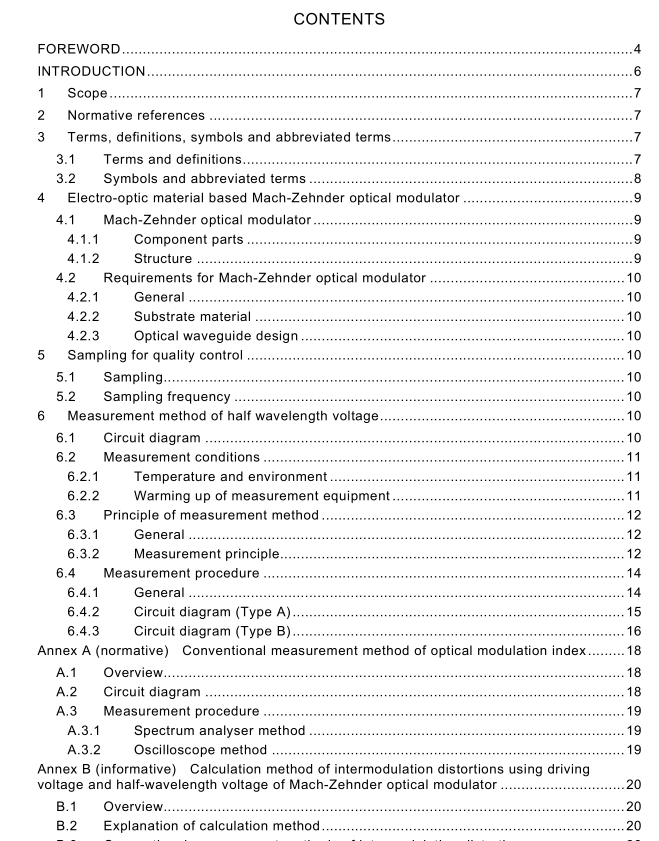IEC 62801 pdf – Measurement method of half-wavelength voltage for Mach-Zehnder optical modulator in wireless communication and broadcasting systems

IEC 62801 pdf – Measurement method of half-wavelength voltage for Mach-Zehnder optical modulator in wireless communication and broadcasting systems
1 scope
This document specifies a measurement method of half-wavelength voltage applicable toMach-Zehnder optical modulators in wireless communication and broadcasting systems. Inaddition,this method is also effective for the estimation of the intermodulation distortion ofMach-Zehnder optical modulators.The method applies for the following:
frequency range: 10 MHz to 30 GHz;
-wavelength band: 0,8 um to 2,0 um;
electro-optic material based Mach-Zehnder optical modulators and their modules.
2 Normative references
The following documents are referred to in the text in such a way that some or all of their contentconstitutes requirements of this document.For dated references, only the edition cited applies.For undated references,the latest edition of the referenced document (including anyamendments ) applies.
IEC 62007-1, Semiconductor optoelectronic devices for fibre optic system applications – Part 1:Essential ratings and characteristics
IEC 62007-2,Semiconductor optoelectronic devices for fibre optic system applications-Part 2:Measurement methods
3Terms, definitions, symbols and abbreviated terms
3.1 Terms and definitions
For the purposes of this document,the terms and definitions given in IEC 62007-1 andIEC 62007-2 and the following apply.
Iso and lEC maintain terminological databases for use in standardization at the followingaddresses:
.IEC Electropedia: available at http://www.electropedia.orgl
. ISo Online browsing platform: available at http://www.iso.orglobp3.1.1
half-wavelength voltageVT
voltage required for a Pockels effect material based Mach-Zehnder optical modulator to inducea phase shift of one-half a wavelength between the lightwaves of two arms of the Mach-Zehnderinterferometer
Note 1 to entry: lt corresponds to an ON/OFF voltage of the Mach-Zehnder optical modulator as shown in Figure 1
3.1.2
normalized optical modulation indexNOMI
for the Mach-Zehnder optical modulator, ratio of driving voltage and half-wavelength voltage ofthe modulator, defined as
NOMIl = (Vpp/ Vn)×100 [%]
(1)
where
yppis the driving voltage (peak to peak voltage);Vnis the half-wavelength voltage
Note 1 to entry: NOMl does not denote actual optical modulation index (OMI), defined as the ratio of the opticalmodulated signal power and the average optical power. Detailed explanations of OMl including measurement methodsare described in Annex A.
Note 2 to entry: This note applies to the French language only.3.1.3
extinction ratioRext
ratio of two optical power levels of the optical signal generated by the optical modulator, definedas
Rext = 10log(P,/Pz)
(2)
where
Pis the optical power level generated when the output power is “on”;P2is the power level generated when the output power is “off”
3.2symbols and abbreviated terms
The symbols and abbreviated terms used in this document are shown in Table 1.
4 Electro-optic material based Mach-Zehnder optical modulator
4.1 Mach-Zehnder optical modulator
4.1.1 Component parts
The optical modulators and their modules consist of basic parts as follows:
– Mach-Zehnder interferometer type optical modulator;
– input and output fibre pigtails (where appropriate);
– bias control port (where appropriate);
– photodiode for bias monitoring (where appropriate);
– laser diode for light source (where appropriate);
– thermal sensor (where appropriate);
– Peltier element (where appropriate).
4.1.2 Structure
A basic structure of the Mach-Zehnder interferometer type optical modulators is shown in Figure 2. The modulators are grouped by electrode types and options.
– Electrode: lumped type, traveling-wave type, etc.
– Options: optical isolator, photodiode, half-mirror, laser diode, etc.
4.2 Requirements for Mach-Zehnder optical modulator
4.2.1 General This method is based on the theoretical transfer curve of the electro-optic material based Mach-Zehnder interferometer, where the phase shift of traveling light on each arm of the interferometer should be proportional to the applied voltage, and the power of traveling lightwaves in each arm are almost the same. Requirements for this measurement method and applicable for the modulator are given in 4.2.2 and 4.2.3.
4.2.2 Substrate material The main substrate materials of the modulator shall be materials such as LiNbO 3 , LiTaO 3 , KH 2 PO 4 , PZT, PLZT, InP, GaAs, InGaAs, InAlAs, InGaAsP, CLD type chromophore containing polymer, FTC type chromophore containing polymer, etc., which realize an electro-optic effect (Pockels effect). If strictly considered, semiconductor materials do not possess a pure electro optic effect, however, the semiconductor Mach-Zehnder modulators can be adjudged as electro-optic material based Mach-Zehnder modulators.
4.2.3 Optical waveguide design The optical waveguide shall be designed as a single Mach-Zehnder interferometer type comprised of two Y-junctions or symmetric directional couplers and parallel waveguides. Reflection type Mach-Zehnder optical modulators are included. 5 Sampling for quality control 5.1 Sampling A statistically significant sampling plan shall be agreed upon by the user and supplier. Sampled devices shall be randomly selected and representative of production population, and shall satisfy the quality assurance criteria using the proposed test methods.









